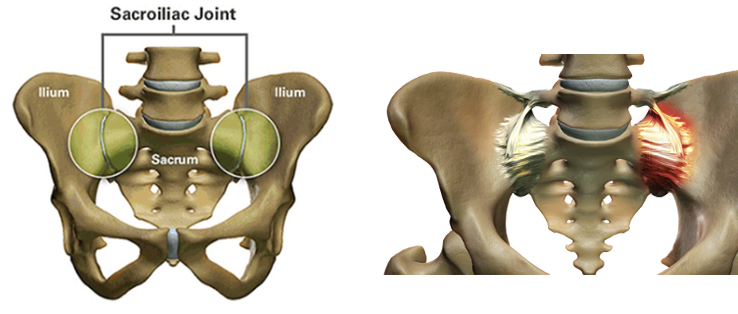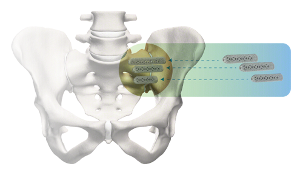SI Joint Fusion With the iFuse Implant System®
Experiencing SI Joint Pain?
The sacroiliac (SI) joint, a critical component in the lower back, plays a significant role in the prevalence of back pain. Clinical research has highlighted the SI joint as a primary source of discomfort for 15 to 30 percent of individuals suffering from chronic lower back pain. This connection underscores the complexity of back pain and the importance of accurately identifying pain sources for effective treatment.
Moreover, the SI joint's involvement becomes more pronounced in postsurgical scenarios. Among patients who have undergone a lumbar fusion, up to 43 percent report that the SI joint is responsible for ongoing or newly developed lower back pain. This statistic reveals a notable concern for patients post-surgery, indicating that the SI joint's role in back pain is both significant and often under-recognized.
These findings emphasize the need for comprehensive evaluation in lower back pain management, considering the SI joint as a potential key pain generator, especially in cases where lumbar fusion has been performed. Understanding the role of the SI joint in back pain is crucial for developing effective treatment plans and improving patient outcomes.
SI Joint Anatomy

The sacroiliac joint, situated in the pelvis, acts as a crucial linkage between the iliac bones and the sacrum—the lowest portion of the spine just above the tailbone. Responsible for facilitating energy transfer between the legs and the torso, this joint, like others in the body, is susceptible to injury and degeneration.
When the SI joint becomes compromised, individuals commonly experience pain in the buttocks, often extending to the lower back, hips, and legs. This discomfort is notably prominent during activities such as lifting, running, walking, or even when lying on the affected side.
What makes SI joint issues challenging is their similarity to other conditions like disc-related lower back pain or hip and groin discomfort. As a result, healthcare providers should consistently consider SI joint disorders in their diagnosis of lower back, hip, or pelvic pain.
Symptoms
If you experience one or more of the symptoms below, it might be time to see an expert.
- Pain in the lower back
- Lower extremity pain, numbness, tingling, and weakness
- Pelvis and buttock pain
- Pain in the hip and groin area
- Sensation of instability in the leg, such as buckling or giving way
- Disrupted sleep due to discomfort
- Difficulty with sitting for extended periods or needing to sit on one side
- Pain experienced while transitioning from sitting to standing

Diagnosis
Several tests conducted during a physical examination can help identify the SI joint as the underlying cause of your symptoms. Sometimes, X-rays, CT scans, or MRIs are useful in diagnosing SI joint–related issues by ruling out other potential sources of pain, such as the lumbar spine or hip joints. It's important to note that concurrent conditions, like disc problems, might also exist alongside SI joint disorders.
The most reliable method to precisely determine if the SI joint is causing your lower back pain involves a diagnostic injection of a local anesthetic into the SI joint. This injection, guided by X-ray or CT, confirms the accurate placement of the needle in the joint. If your symptoms reduce by at least 50 percent, it's likely that the SI joint is either the source or a significant contributor to your lower back, hip, or pelvic discomfort. Conversely, if the pain level remains unchanged post-injection, the likelihood of the SI joint causing your pain decreases, and your doctor may look into other possible conditions.
Treatment Options
After establishing that the SI joint is responsible for your symptoms, the focus shifts to treatment. Many patients experience positive results from physical therapy, oral medications, or injection therapy. However, it's common for these treatments to be repetitive and provide only temporary relief of symptoms. If you've pursued nonsurgical treatments without achieving lasting relief, your surgeon might explore other alternatives, such as the minimally invasive iFuse procedure.
SI Joint Fusion With the iFuse Implant System
Utilized by fellowship-trained spine surgeon Dr. Allister Williams, the iFuse Implant System is specifically engineered for the stabilization and fusion of the SI joint. Involving the insertion of three triangular titanium implants across the sacroiliac joint, the iFuse procedure is aimed at bolstering joint stability, reducing pain, and improving function. This process is conducted through a one-inch incision and typically takes about an hour.

Notably, the iFuse system, with its unique triangular design, stands as the most clinically evaluated method for SI joint fusion, backed by over 100 peer-reviewed publications. These studies attest to the safety, effectiveness, and biomechanical and economic benefits of the implant. The iFuse implant is also distinguished as the only SI joint fusion device supported by multiple forward-looking clinical studies, including two controlled trials, underscoring its effectiveness in pain reduction, improved patient function, and enhanced quality of life.
As with any surgical procedure, especially those that are minimally invasive, it may not be suitable for every patient as each patient is unique.
To see if you’re a good candidate for an SI joint fusion with the iFuse Implant System with Dr. Williams, call (570) 421-7020 to schedule an appointment in East Stroudsburg, Tobyhanna, Brodheadsville, or Milford or schedule an appointment online.
